Julien Richard-Foy, Wojciech Mazur
To what extent do programming languages affect the energy consumption of programs? How does Scala compare to the other programming languages? Does that matter for building an environmentally sustainable digital world?
We found out that the most important lever to reduce the energy consumption of the IT sector is to extend the lifetime of hardware. Nevertheless, the energy consumption due to running software is important, and it varies significantly between programming languages. Scala is well positioned for a high-level language, and writing low-level imperative code can make a difference.
The world is warming, what about the digital world?
According to climate experts, it is urgent to assess the environmental impact of our decisions (in all areas) to significantly reduce the greenhouse-gas (GHG) emissions of human activities.
In 2019, the sector of IT was responsible for 3.5% of the worldwide GHG emissions 1 2, which is similar to the aviation sector. More importantly, this number is growing exponentially, and it is expected to double between now and 2025 1. This trajectory is obviously not sustainable. The GHG emissions of the IT sector must decrease.
In that regard, good news is that more and more IT companies are committing to targeting carbon neutrality, including Scala companies such as Netflix, Zalando, and Stripe.
Where do we start? If we break down the GHG emissions within the IT sector, we observe that most of them happen during the manufacturing process of hardware rather than during the usage of hardware 1 3. Therefore, the first action point is to extend the lifetime of hardware.
Then, we can have a look at the emissions due to using hardware, namely the emissions due to running software.
Do programming languages affect energy consumption?
The GHG emissions due to running software are caused by the energy consumption of computers. Obviously, the more computations are performed, the more energy is consumed. Said otherwise, the nature of the program is more important than the language in which it is written.
That being said, if we implemented the exact same program in various languages, would we observe significant differences in energy consumption, solely due to intrinsic language overhead? This is the question Rui Pereira et. al. try to answer.
They compared the execution time, energy consumption, and memory consumption of running 10 different programs each implemented in 27 programming languages 4. Caution needs to be taken when interpreting benchmark results, but some general trends emerged.
Notably, the energy consumption does vary by factors up to 80 between programming languages. On average, C and Rust programs are the most energy efficient. Java programs consume about 2 times more energy than C programs. JavaScript/TypeScript programs consume between 4 to 20 times more energy than C programs. Finally, Python programs are black sheeps, with an energy consumption 75 times higher than C programs.
Where does Scala stand in this picture? Unfortunately, Scala was not included in this study.
Including Scala in the energy benchmarks
The code used by the study is open source. It reuses the benchmarks of the Computer Language Benchmarks Game, and measures not only the execution time and memory consumption, but also the energy consumption (via perf tools).
In order to include Scala, we had the following plan:
- take old Scala implementations of the benchmarks (which were written at a time where Scala was part of the Computer Language Benchmarks Game, and which are now sitting in an archived Git repository),
- adapt the infrastructure created by the study to run Java benchmarks to also run Scala benchmarks.
However, things were not that simple in practice. First, we discovered that the existing infrastructure was not properly warming-up the JVM before running the benchmarks, leading to an over-estimation of about 30% of their energy consumption. Second, and more importantly, we noticed that the different implementations of the same benchmarks (one per programming language) were sometimes using different algorithms, making things obviously less comparable.
We managed to find a solution to the first issue by implementing a JVM-based runner for the benchmarks. Our runner implements the classic scheme of running several warming-up iterations before doing measurements. It measures the energy consumption by using jRAPL.
Dealing with the second issue was a bit less satisfactory. We don’t have the capacity of checking and fixing the 50 benchmark implementations to use comparable algorithms. Consequently, we only focused on the Java and Scala benchmarks whose performance was too far behind their C counterpart. We modified them, when necessary, to use the same algorithm as the C implementation of the benchmark.
After several days of work, we had 10 Scala implementations of the benchmarks as well as an infrastructure properly warming-up the JVM before measuring their execution time, memory consumption, and energy consumption.
What about day-to-day code?
Heavily optimized code may be different from idiomatic code that we write day-to-day, and the results we would get from running the benchmarks may not be applicable to idiomatic Scala code.
For this reason, we also created “more idiomatic” versions of the Scala benchmarks. The usage of the double quotes is justified because 1) what is qualified as idiomatic is fairly subjective, and 2) due to our limited resources, we did not completely overhaul the implementations, but we only changed some patterns that we believe are typically non-idiomatic.
For instance, the “optimized” version of the binary-trees benchmark models
an empty tree as tree whose branches are null:
final case class Tree(left: Tree, right: Tree) {
def checkSum: Int =
left match {
case null => 1
case tl => 1 + tl.checkSum + right.checkSum
}
}
object Tree {
final val EmptyTree = Tree(null, null)
}
Whereas the idiomatic one uses a class hierarchy:
sealed trait Tree {
def checkSum: Int
}
case class NonEmptyTree(left: Tree, right: Tree) extends Tree {
def checkSum: Int = 1 + left.checkSum + right.checkSum
}
case object EmptyTree extends Tree {
def checkSum: Int = 1
}
Does this change impact performance? Keep reading to know the answer.
Another example of difference between idiomatic and optimized versions is the
usage of Scala collections instead of Java Arrays, and the usage of for
loop instead of while loops.
Protocol
We compared the energy consumption of 10 benchmarks, each written in C, Scala, Java, JavaScript, and Python. To achieve this, we executed each benchmark 10 times (after 5 warm-up iterations), on an Intel i9-7900X @ 3.30 GHz with 20 CPUs and 128 GB of memory, with OpenJDK 17, Node 10.19.0, and Python 3.8.10.
You can find the source code of the benchmarks in the following Git repository: https://github.com/WojciechMazur/Energy-Languages.
Results
To visualize better how the languages compare (regardless of the nature of the benchmarks), we normalized the measurements, using C as a baseline.
The figure below shows the normalized average energy consumption for each benchmark, for the languages C, Java, and Scala (lower is better):
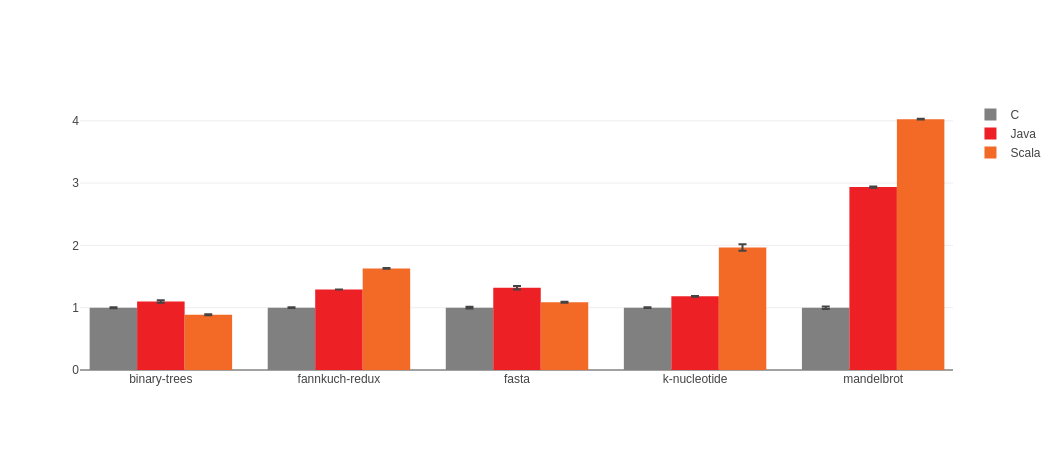
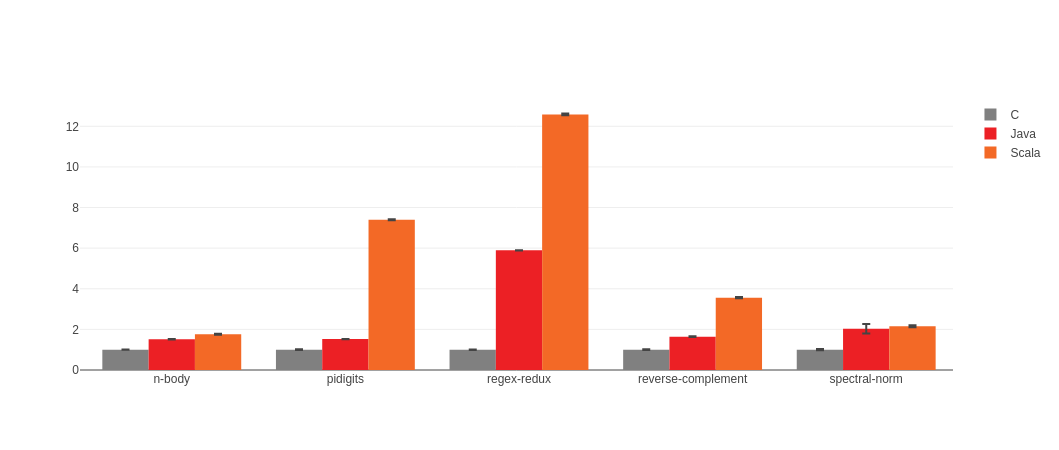
We observe that the Scala benchmarks were sometimes consuming a similar
amount of energy as the C benchmark (this is the case for binary-trees,
fannkuch-redux, fasta, and n-body), and sometimes a significantly higher
amount of energy (up to 12 times more energy for regex-redux).
The figure below shows the same information, but it now includes JavaScript and Python:
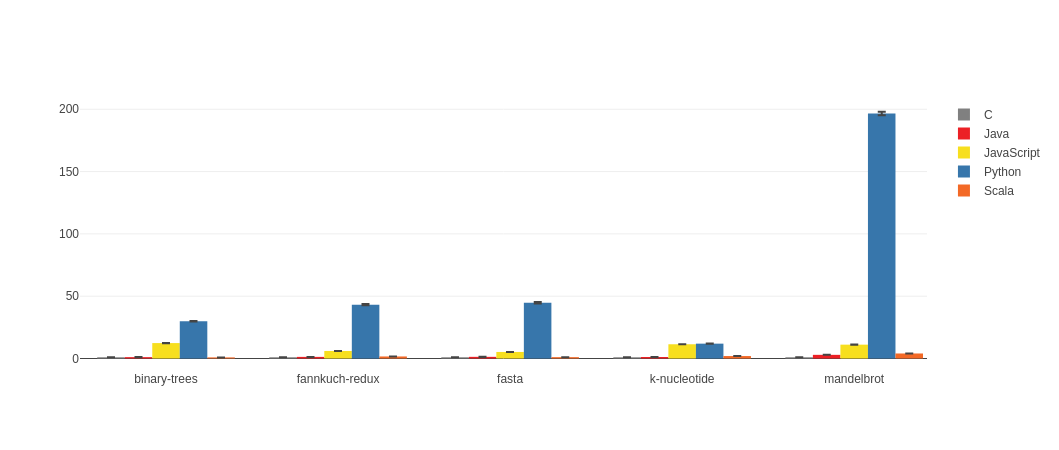
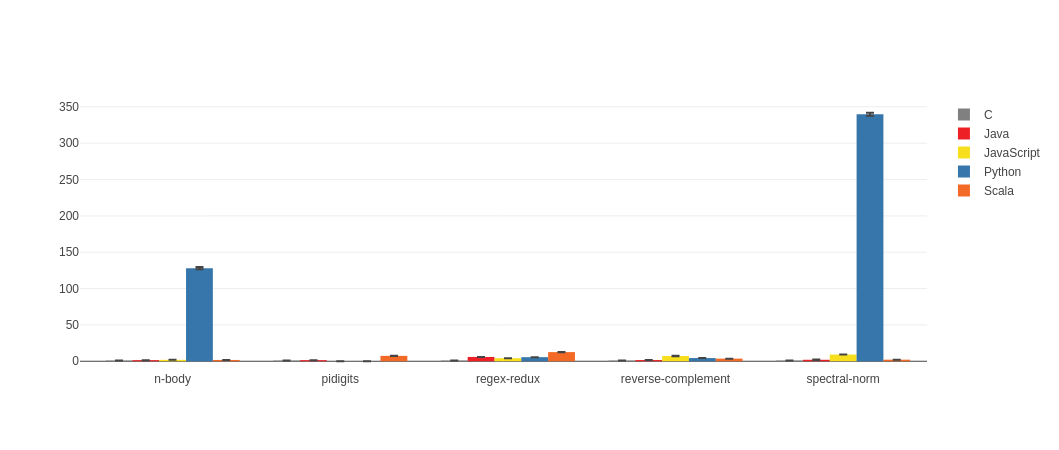
Compared to C, the Python benchmarks consumed between 4 to 339 times more energy, and the JavaScript benchmarks consumed between 2 to 12 times more energy.
Last, the figure below compares C, Java, Scala, and “idiomatic” Scala benchmarks:
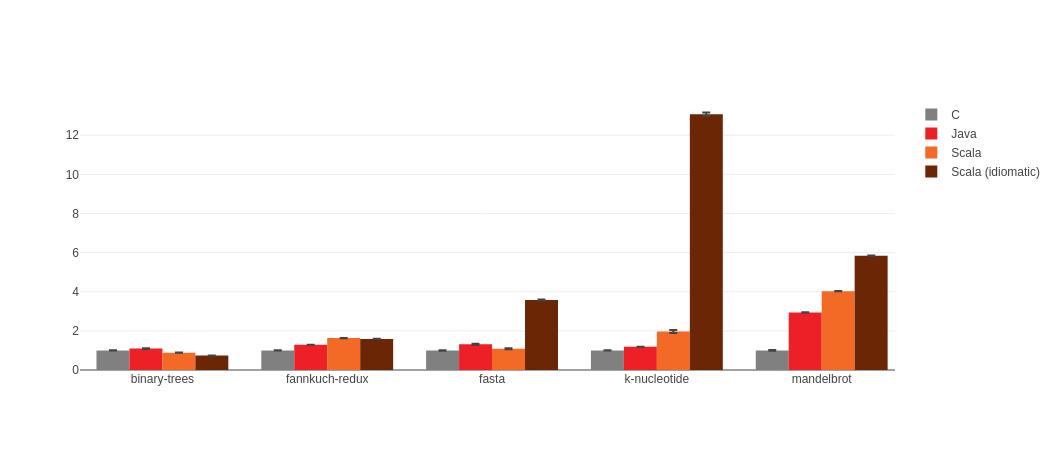
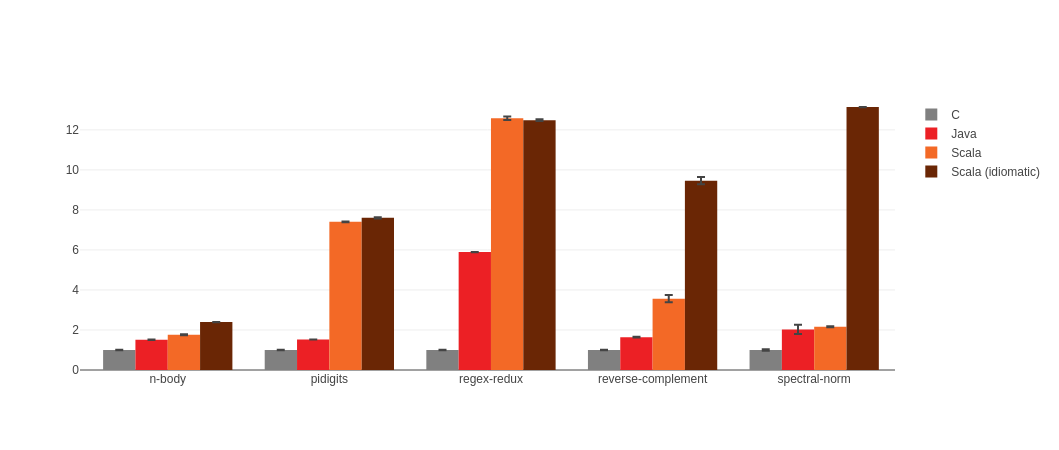
For some benchmarks, the idiomatic version performs as well as the optimized
one (for binary-trees, the idiomatic version performs even slightly better
than the – supposedly – optimized one). However, for some other benchmarks,
the idiomatic version consumes significantly more energy than the optimized
one (up to 7 times more energy for k-nucleotide).
Discussion
Within a language, we observe a high variability between benchmarks (e.g., Python consumed between 4 to 300 times more energy than C, depending on which benchmark we look at). This makes it hard to draw general conclusions like “language X consumes N times more energy than language Y”. That being said, we believe that computing, for every language, their average energy consumption relative to C provides an order of magnitude of how the language may perform. The table below shows the average energy consumption relative to C, as well as the standard deviation:
| Language | Average energy consumption (normalized) | Standard Deviation |
|---|---|---|
| C | 1.00 | 0.00 |
| Java | 2.04 | 1.45 |
| Scala | 3.71 | 3.67 |
| Scala (idiomatic) | 6.99 | 4.87 |
| JavaScript | 7.63 | 3.62 |
| Python | 89.33 | 113.79 |
A similar table was shown by Rui Pereira et. al 4. While we did not get exactly the same numbers, the orders of magnitude remain the same.
We now have an answer to our initial question, “where does Scala stand in the picture?” According to these benchmarks, Scala is well positioned within high-level programming languages.
Also, we see that in Scala, two implementations of the same benchmark can
easily show different performances, depending on your code style. For
instance, the energy consumption of the k-nucleotide benchmark was between
2 to 13 times higher than the C implementation. The differences between both
versions are mainly the usage of immutable Scala collections and for loops in
the idiomatic version, as opposed to Arrays and while loops in the
optimized version (this observation is consistent with the results of
another study ran by Rui Pereira et. al. 5).
We believe that the fact that Scala embraces several programming paradigms is a strength. It makes it easy to write high-level code that reads well, and it also makes it easy to write low-level code that performs well.
Next steps
This work measured the performance of Scala on the JVM platform only. What about Scala.js and Scala Native? Including those platforms could be achieved in a follow-up study.
The Scala Center started this work to get a first rough idea of what it entails to reduce the GHG emissions of running software written in Scala, but also, and more importantly, to see if there is any interest from companies that use Scala into consolidating the methodology and tools to reach their sustainable development goals. Please get in touch with us if you want to be part of it!
-
The Shift Project. (2021, March). Impact environnemental du numérique. https://theshiftproject.org/article/impact-environnemental-du-numerique-5g-nouvelle-etude-du-shift/ ↩ ↩2 ↩3
-
Freitag, C., Berners-Lee, M., Widdicks, K., Knowles, B., Blair, G., & Friday, A. (2021). The climate impact of ICT: A review of estimates, trends and regulations. arXiv preprint arXiv:2102.02622. ↩
-
Gupta, U., Kim, Y. G., Lee, S., Tse, J., Lee, H. H. S., Wei, G. Y., … & Wu, C. J. (2021, February). Chasing Carbon: The Elusive Environmental Footprint of Computing. In 2021 IEEE International Symposium on High-Performance Computer Architecture (HPCA) (pp. 854-867). IEEE. ↩
-
Rui Pereira, Marco Couto, Francisco Ribeiro, Rui Rua, Jácome Cunha, João Paulo Fernandes, and João Saraiva. 2017. Energy efficiency across programming languages: how do energy, time, and memory relate? In Proceedings of the 10th ACM SIGPLAN International Conference on Software Language Engineering (SLE 2017). Association for Computing Machinery, New York, NY, USA, 256–267. DOI:https://doi.org/10.1145/3136014.3136031 ↩ ↩2
-
Pereira, R., Couto, M., Ribeiro, F., Rua, R., Cunha, J., Fernandes, J. P., & Saraiva, J. (2021). Ranking programming languages by energy efficiency. Science of Computer Programming, 205, 102609. ↩